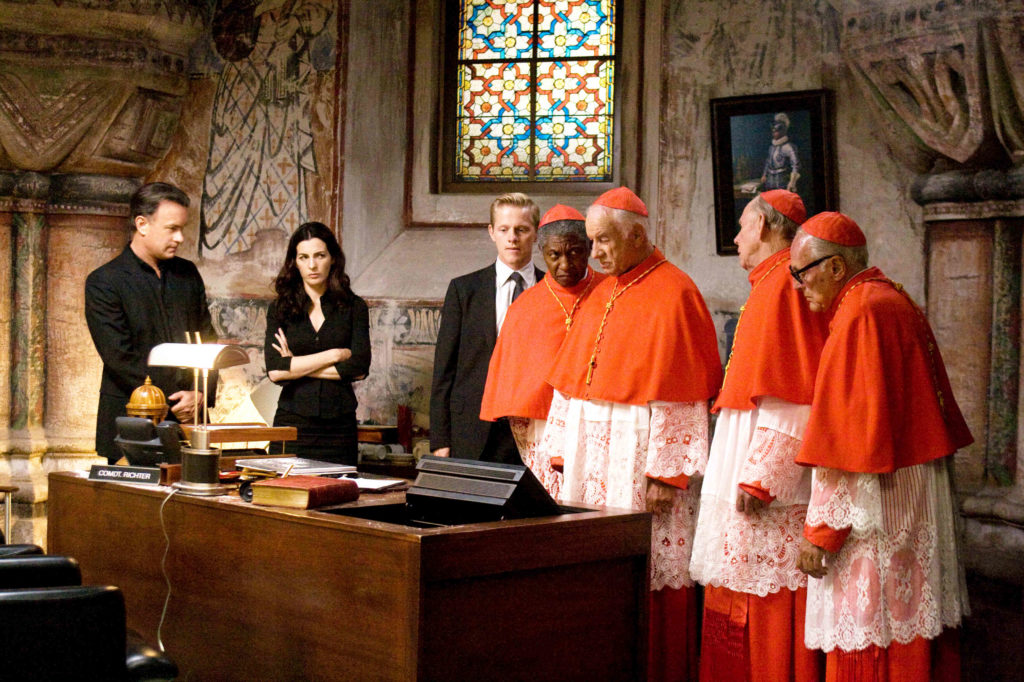
A beloved pope passes. Subatomic particles collide. Influential priests vanish. An ancient adversary of the Catholic Church reemerges. And one cryptic word ties it all together: Illuminati.
Such is the stuff of Angels & Demons, the big-screen sequel to 2006’s The Da Vinci Code.
Swept into the center of the ominous intrigue that engulfs the Vatican is renowned symbologist Robert Langdon. Though there’s no love lost between the skeptical Harvard scholar and Catholic Church officials, he’s the man they call when four cardinals, all top-ranking candidates for the now vacant Holy See, go missing.
The perpetrators, if a cryptic note left behind is to be believed, are agents of the Illuminati, a shadowy underground brotherhood bent on retribution for the Church’s persecution of scientists four centuries before. But the group’s goals are bigger—and far more sinister—than just kidnapping and executing the cardinals.
The Illuminati’s endgame is nothing short of the decimation of Roman Catholicism itself, a plan to be achieved by detonating a pilfered container of powerful antimatter engineered by nuclear physicists in Switzerland. In other words, using a cutting edge scientific advancement to level a religious organization with a long history of suppressing scientific advancement.
Racing against time to save the cardinals and the Vatican itself, Langdon finds allies in Italian physicist Vittoria Vetra and the man entrusted with the papal office’s administrative authority between pontiffs, an earnest young priest named Patrick McKenna.
But as Langdon and Co. uncover clues, search crypts and dodge bullets, the chilling extent to which evil has infiltrated the Church becomes ever more clear.
The central philosophical conflict in Angels & Demons revolves around the tension between faith and science. Its resolution ultimately delivers a positive message about the relationship between these two disciplines, namely that they’re both necessary and can peacefully coexist. (More on this in my “Conclusion.”)
Langdon serves as the Church’s unlikely defender as he and Vittoria delve into the mystery surrounding the Illuminati’s sudden reappearance. He is tenacious in his pursuit of hidden knowledge that offers critical clues regarding the Illuminati’s next steps. But Langdon’s not content to dig through ancient documents while piecing together old clues; he’s committed to trying to rescue the kidnapped cardinals—all by himself if he has to. In so doing, he and others often risk (or lose) their lives.
Take a deep breath—there’s a lot to talk about here. The Illuminati, Langdon tells us, was formed as a reaction to the Roman Catholic Church’s clampdown on scientists around the time Galileo posited that Earth wasn’t the center of the universe. These dissident scientists became radicalized (we’re told) when the Church branded four of them with a cross and then executed them for what it considered heretical scientific claims. That alleged event in 1668, dubbed la purga, fuels the Illuminati’s motivation to “sacrifice” the Church “upon the altar of science.”
A Vatican official in the film describes the event as “a dark stain on the church,” a position that more characters than not seem to adopt. Though some in the church are depicted as slow to embrace this message—one official wonders, “If science has the power to create, what is left for God?”—the film ends with a new pope reiterating and reinforcing the idea that faith and science do not have to be enemies, that the world needs both. He even takes the name Luke—the first pope to do so—as a reference to the gospel writer’s scientific profession.
There’s also a lot of conversation between Langdon and other characters about the subject of faith. McKenna asks the scientist,” Do you believe in God, sir?” Langdon replies, “I am an academic, and my mind tells me I will never understand God.” McKenna rephrases his inquiry: “And your heart?” Langdon responds, “It tells me I’m not meant to. Faith is a gift that I’ve yet to receive.”
Along similar lines, an old cardinal named Strauss tells Langdon, “Thanks be to God for sending someone to protect His Church.” When Langdon protests that he doesn’t believe God sent him, the cardinal smiles and tells him, “Oh, my son, of course He did.” Strauss also emphasizes that religion—not God—is by nature flawed because the human beings who conduct it are themselves flawed individuals.
Elsewhere, a hostile Vatican security agent says to Langdon, “My Church comforts the sick and the hungry, comforts the dying. What does your church do?”
And Strauss seems dismissive of the possibility of many Catholics and cardinals dying, saying that they’ll all go to heaven anyway. He also talks about God’s will being done (when it looks like things are going his way in a power play) and condescendingly tells McKenna, “God answers all prayers.” But one of the prayers McKenna offers, it turns out, isn’t to God at all but to the deceased pope.
A kidnapped cardinal tells his assailant, “May God forgive you for what you’ve done.” The violent kidnapper quips in response, “Father, if God has issues, it won’t be with what I’ve done, but with what I’m about to do.” An assassin claims that the church made him a sinner, and mentions the Lord, Allah and Yahweh in a confused speech aimed at trying to justify his vocation by saying that people of all faiths employ him to kill in the name of God. Indeed, he claims that he’s imitating God, who is vengeful. Similarly disturbed, a man prays, “Father, into your hands I commit your spirit” before committing suicide.
After scientists successfully create a small quantity of antimatter, one says solemnly, “We are in God’s hands now.” Describing her research into antimatter, Vittoria says that it has been dubbed the “god particle” because scientists believe that such matter was present at the moment of creation.
Of note is the fact that Angels & Demons cinematically details the selection process for a new pope. We’re shown how the Church’s cardinals are sequestered in a decision-making process called the conclave, as well as how the voting procedure (supposedly) works. At times, it seems quite messy as various factions vie for power. And the new pope’s first official act is to spin the events of the past day, letting lies leak which frame the Church in the best possible light. Other times, the messiness is depicted as something under divine control. One cardinal, for example, talks glowingly of relying upon the Holy Spirit’s guidance throughout the process.
A conversation within the Vatican references Pope Pious IX “castrating” a number of nude statues so that they wouldn’t cause anyone to lust. The camera lingers on the ornamental leaves that were later grafted onto the stone. Another piece of art reveals parts of the female form.
Violence—some of it quite graphic—punctuates the film’s religious repartee. Two men are lit on fire and burn to death as the camera focuses on their writhing, screaming forms. An assassin slices a police officer’s throat. Rats gnaw on the head and face of a deceased man. Five men get branded with a hot iron. In most cases we see the cauterized wounds; in one case we see the painful contact.
Elsewhere, the camera finds an eyeball not far from the bloody body of the man it came from. (He’s been shot and killed). A man bleeds to death after his lungs are punctured—rendering CPR useless. Blood spurts onto Langdon. And we see lots of blood on the ground; a young girl’s doll is covered with it when she picks it up. Suspicion arises regarding the pope’s death, and several people look at his already badly decomposing body.
More than half-a-dozen other people are shot in the course of several scenes, one of them in the head at close range. A car explodes and kills a man. We see the four cardinals confined in a dungeon-like prison. One of them is later bound and tossed into a fountain after being branded. Langdon falls into a crypt full of skulls.
Langdon and another man find themselves trapped in a hermetically sealed library when the power (and the oxygen flow) get turned off. Langdon uses a gun and a large bookshelf to break through the glass walls. A conflict between Catholics condemning stem cell research and protesters who favor it leads to a small riot in St. Peter’s Square.
Characters take God’s name in vain half-a-dozen times (including one pairing with “d‑-n”). A combined handful of vulgarities includes “b‑‑tard,” “h‑‑‑” and “d‑‑mit.”
A cardinal and a Vatican security official smoke in separate scenes.
Against the majestic backdrop of Rome’s ancient cathedrals and spiritual spaces, an agnostic researcher races to save a Church he doesn’t much believe in … but a Church that absolutely needs him. It’s a premise full of paradox.
And ripe, it might seem, for controversy. And it may still create some. But what director Ron Howard (who also helmed The Da Vinci Code) throws moviegoers here is something of a curveball.
Angels & Demons is drenched in religious imagery and deals with significant spiritual subjects. At the fore is this question: Can science and religion coexist peacefully, or is their relationship doomed to be forever marred by retributive rancor? The Church, we’re told, hasn’t always gotten this important question right … with horrific consequences.
Instead of relentlessly asserting that the Roman Catholic tradition is impervious to change, though, Howard generally portrays its leaders as men who try to take responsibility for past wrongs. They’re not perfect. But, to their credit, they don’t claim to be. The film’s answer to that question of science and faith? The two needn’t be mutually exclusive. Instead, both have their place in the lives of billions of people trying to make sense of the world around them. And, above all, violent responses to philosophical and spiritual differences should stay where they belong: in the past.
Responding to the film, reviewers at the official Vatican newspaper, L’Osservatore Romano, offered only mild criticism of historical inaccuracies, and generally characterized Angels & Demons as “more than two hours of harmless entertainment, which hardly affects the genius and mystery of Christianity.” They even noted, “This time, the church is on the side of the good guys.”
It’s not that simple, of course. It never is. After all, the Church ends up deliberately deceiving the world as the film ends by covering up significant events. But the net result still feels less like the religious treatise (or thinly veiled propaganda statement) that the last adaptation of a Dan Brown novel, The Da Vinci Code, was, and more like an overly spiritualized (and violent) mash-up of National Treasure, Raiders of the Lost Ark, CSI and 24.


After serving as an associate editor at NavPress’ Discipleship Journal and consulting editor for Current Thoughts and Trends, Adam now oversees the editing and publishing of Plugged In’s reviews as the site’s director. He and his wife, Jennifer, have three children. In their free time, the Holzes enjoy playing games, a variety of musical instruments, swimming and … watching movies.
Our weekly newsletter will keep you in the loop on the biggest things happening in entertainment and technology. Sign up today, and we’ll send you a chapter from the new Plugged In book, Becoming a Screen-Savvy Family, that focuses on how to implement a “screentime reset” in your family!